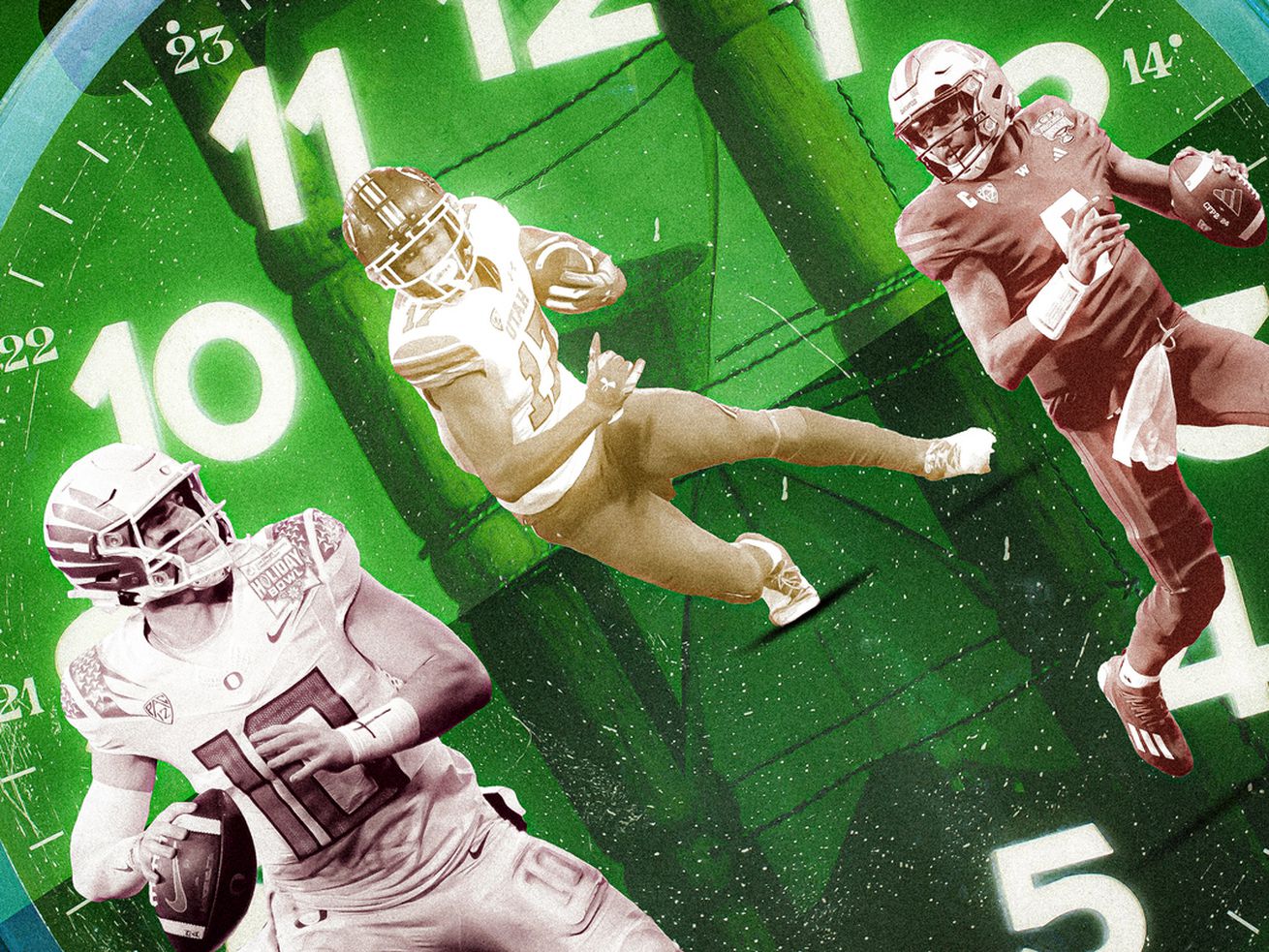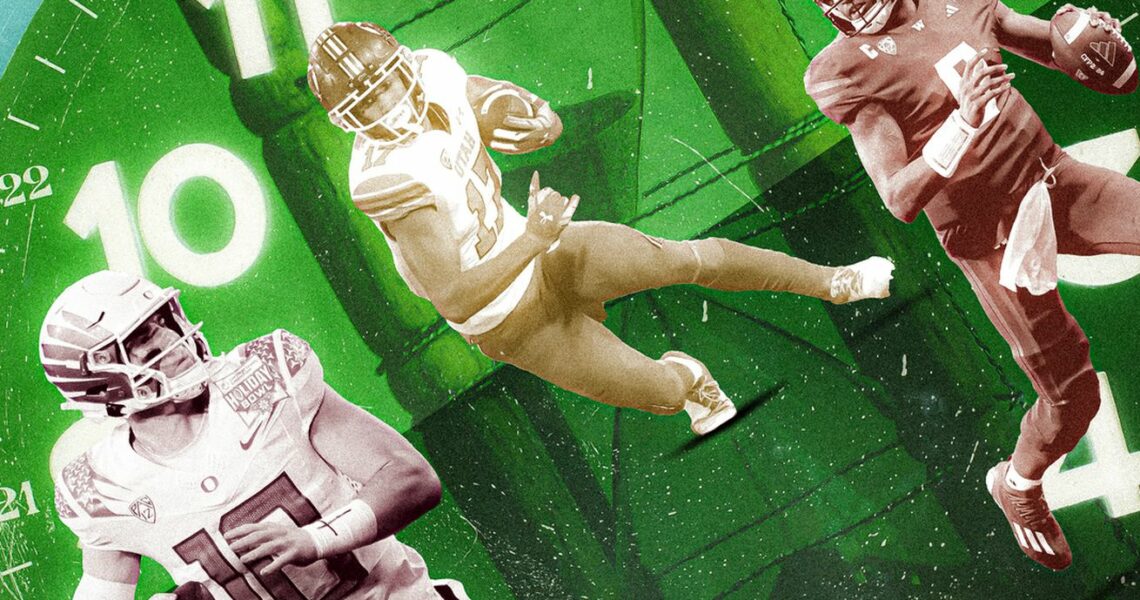
College football’s changing landscape is starting to impact the NFL draft, with older prospects—particularly at quarterback—and a thinner draft class.
Devaughn Vele took the scenic route to the NFL draft. His chops as a wide receiver at Rancho Bernardo High School in San Diego were good enough to earn him invites to a handful of showcases, including the Polynesian All-American Bowl, but not good enough to get him a single Division I scholarship offer. Absent that opportunity, Vele decided to put off college and spend his next two years on a religious mission in Samoa. He enrolled in college at Utah in 2019, joined the football team as a walk-on, and redshirted his first season. Five years later, Vele has 47 collegiate games, 28 starts, and nearly 1,700 receiving yards to his name. He finally earned a scholarship in 2020, and in 2022, he was an honorable mention All-Pac-12 player. Vele’s not a top draft prospect, but he earned an invitation to the NFL scouting combine. He might wind up as a priority undrafted free agent for a team, or he might get drafted in one of the later rounds.
And he is 26 years old.
“This isn’t foreign territory to me,” Vele said at the combine. “I’ve been a walk-on before. Whether I get drafted in a late round, undrafted, it doesn’t mean anything to me. I’m just going to have that same hunger, and I feel like I’m going to prove a lot of people wrong.”
In one sense, Vele is an outlier as one of the oldest players in this year’s draft. There won’t be a lot of 26-year-old rookies running around team minicamps in May. In another sense, though, he’s just a dramatic example of a wider trend. In the college football landscape marked by redshirt years, the transfer portal, eligibility extensions granted during the pandemic, and NIL money that gives prospects who aren’t sure of their draft chances less incentive to declare early, this year’s draft class is a bit long in the tooth.
“Because everybody got to stay, college football at large is older,” Vikings general manager Kwesi Adofo-Mensah said at the combine. “You can’t go back and study it historically because this is new. So we’re just trying to navigate that.”
But based on the list of over 400 prospects in Dane Brugler’s “The Beast” draft guide for The Athletic, the average prospect this year is a practically geriatric 23.24 years old. There may not be that many Devaughn Vele’s in this class, but if he dropped, say, a Lost reference at the combine, at least a few of his peers would have gotten it.
This year’s class is older on average than any between 2017 and 2021, though it’s a little younger than the class of 2022 (another post-pandemic draft); an analysis by NFL reporter Kalyn Kahler found that the average 2022 draft pick was borderline millennial at 24.11 years old.
That age—24—is about when scouts and general managers start to consider a prospect’s, um, experience to be something of a red flag. In general, NFL teams prefer younger players over older ones because they assume they’ll enter the league with more room to develop. Before the pandemic, draft picks had been trending younger, particularly those taken in the higher rounds. An analysis by FiveThirtyEight in 2018 showed that, from 2000 to 2018, the average age of a first-round draft pick fell almost a full year, from 22.6 to 21.7. The trend was tied to the advent of the rookie wage scale in 2012, which incentivized top college players to declare for the NFL draft as underclassmen; the sooner they got to the league, the sooner they could sign their second contracts, where the real money gets made. Plus, teams got smarter about things like growth curves through access to better data. The most analytically inclined teams also tend to be the ones drafting the youngest players—the Browns, for example, have almost always drafted young under current general manager Andrew Berry. They have had the lowest average draft pick age in the league during his tenure: 28 of 31 players drafted by Berry were 23 or younger—and usually 22 or younger in the early rounds.
“It’s an interesting dynamic,” said Adofo-Mensah, who worked in the Cleveland front office from 2020-21. “You’re talking about a time in a young man’s life where they’re really rapidly going up their growth curve, strength and athleticism. We know the athletic peak happens, and it doesn’t happen at 20.”
With hundreds of players on draft boards next week, teams will still be able to exercise their preferences for young talent in the early rounds this year. Where general managers worry that an older class could impact their roster is in the later rounds. Younger players become especially coveted in a draft where they are scarce, so more of them figure to be gone by day three.
“I think it has really hampered the depth of the draft, specifically when you get to that last day and then certainly undrafted free agency,” said Cardinals general manager Monti Ossenfort.
That said, because teams see this trend as temporary, as the players impacted by the COVID-19 season cycle through their draft years, the modus operandi around the league is basically just to deal with it until it’s over. If an older draft class really is thinner, meaning fewer seventh-rounders and UDFAs who make rosters in September, the general attitude seems to be: Well, so be it.
“I think after we get through this COVID group of kids that come through, it’ll probably really come back to normal a little bit as far as the normal ages of kids coming out,” Raiders general manager Tom Telesco said in Indianapolis. “Typically as a scouting staff, we always say we’d like a younger player because the guy has a chance to develop, maybe has a little bit more ceiling. Is that true or not? I’m not really sure. But I do know that we’re going to have some players coming in the league that have good experience and may be ready to play a little bit earlier than maybe in times past.”
The NFL’s inclination to draft young is generally backed up by evidence. The same FiveThirtyEight analysis that showed first-round picks were getting younger through the 2010s used Pro Football Reference’s career approximate value stat to look at the performances over time of players drafted in different age brackets. It found that players who started young went on to have better careers. Players drafted at 20 to 21 were only slightly more productive than 22-year-olds, but once players entered the league at 23, the gap widened quickly.
A notable feature of that analysis was that it also found that the same dynamic existed for quarterbacks. Because playing QB is, generally, less physically demanding but more mentally demanding than other positions, college experience is often held up as more meaningful for passers than it is for other players. Multiple executives at the combine brought up that they consider the age dynamics for quarterbacks to be different relative to other positions, and the oldest players in any given draft class are often QBs. The oldest player ever selected in the NFL draft was quarterback Chris Weinke, who was 28 years and 264 days old when the Panthers selected the Heisman Trophy winner out of Florida State in 2000. The oldest player to go in the first round was also a quarterback: Brandon Weeden was 28 years and 195 days old when he was drafted 22nd by the Browns in 2012. (Both Weinke and Weeden played minor league baseball before playing college football.)
And yet, the study found that the improvement in results for quarterbacks drafted at younger ages was actually more dramatic than it was at other positions. NFL teams who drafted quarterbacks aged 21 or younger got significantly more out of them over the course of their careers than they did from quarterbacks drafted 22 or older. In the context of this year’s QB class, that would be good news for Drake Maye and J.J. McCarthy, both 21, but bad news for Jayden Daniels (23), Michael Penix Jr. (24 in May), and Bo Nix (24).
Still, evaluators at least talk about quarterbacks as if they believe age can be an asset. Adofo-Mensah, whose team is clearly in the market for a quarterback in this draft, mentioned he developed his understanding of age curves in Cleveland, which would imply an interest in drafting young. And yet even he called quarterback “one position I feel like it might be a little different.”
“We don’t have a minor league,” Adofo-Mensah said. “And those extra years are maybe a couple of minor league years, depending on where they’re playing, the system, how relatable that is to our game. It’s exciting to talk about. There’s uncertainty. There’s ups, downs, lefts, rights. That’s what makes this hard, and it’s fun.”
Perhaps that talk is cheap—particularly if the Vikings’ rumored infatuation with McCarthy is accurate. Or perhaps these NFL executives are simply hopeful for a few more years of draft picks who remember the Walkman.

